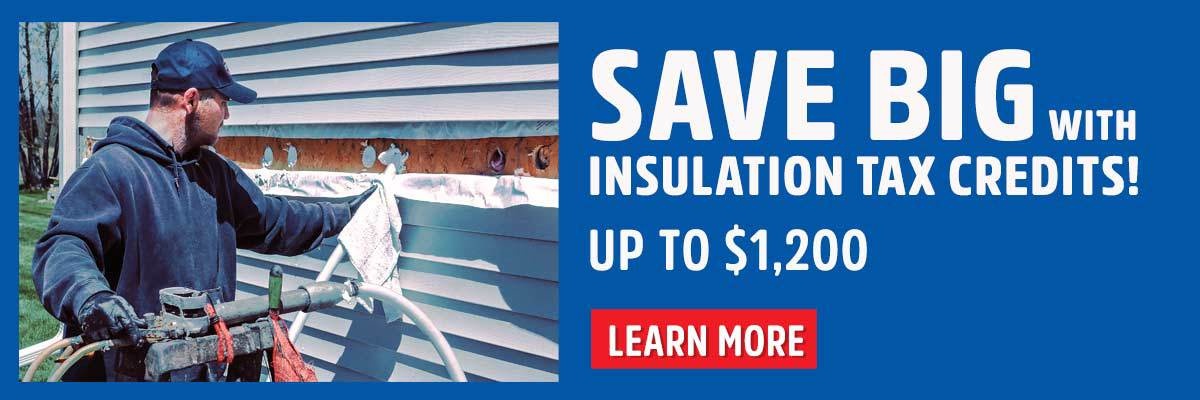Types of Energy Efficient Tax Credits and Insulation Rebates in Michigan


You can get rebates and tax credits for all kinds of things you buy.
Have you bought new tires for your car? You could get a rebate.
Have you purchased a new energy-efficient appliance? You could get a rebate and tax credit for that too.
But did you know you can get tax credits and home insulation rebates in Michigan when you buy home insulation like foam? Depending on the scope of work that is done, you could be eligible for either a mail-in rebate or a home performance rebate from your energy provider, as well as a tax credit.
RetroFoam of Michigan has been recognized by Consumers Energy for its work to get homeowners the best rebate available to them. We were also inducted into an exclusive club after we completed more than 120 home performance projects in one year.
Our primary focus has always been to help homeowners achieve the comfort and energy efficiency they have always dreamed of. As part of that, we also want to make it easier for them, so we make it a point to stay up to date with the energy efficiency tax credit and insulation rebates in Michigan available and the amounts.
During my time here at RetroFoam of Michigan, I have dealt with rebates and tax credits quite a bit, so I’m going to explain what’s available and how you would qualify for them when you choose us for your foam insulation.
Energy Efficiency Rebates and Tax Credits for Insulation for Michigan Homeowners
Before we talk about what rebates for home insulation or energy-efficient tax credits you could be eligible for, first, we should discuss the difference between the two.
A rebate is an incentive program that offers a monetary reward for completing a designated goal. For example, energy providers offer rebates to their customers when they have certain energy-efficient upgrades done to their homes.
A tax credit is an amount of money that can be used to offset against a tax liability. Essentially for the purpose of this article, a tax credit is given when energy-efficient upgrades are done to a home.
Unlike a rebate, a tax credit is not cash in hand. The tax credit is only applied if the homeowner has a tax debt.
So, a rebate is cash in hand or money off the insulation project, and a tax credit for insulation is a credit towards any tax liability the homeowner might have.
Now let’s dive into how Michiganders could be eligible for the standard mail-in insulation rebates, home performance rebates, and the Inflation Reduction Act energy-efficient home improvement credit.
Standard Mail-In Insulation Rebate
The standard mail-in insulation rebate comes into play for homeowners who only insulate one area of their home.
That one area could be the crawl space, rim joist, attic, or walls. It’s important to remember that if you don’t meet the minimum square footage required by your energy provider, you may still not be eligible for this rebate.
This rebate goes directly to the homeowner in the form of a check from their utility provider. Those providers include Consumers Energy, DTE, SEMCO, and Michigan Gas and Utilities.
As part of our contractor concierge service, we file the rebate paperwork for our homeowners, and they receive a check in the mail in about 4 to 6 weeks.
The only thing the energy provider needs for this rebate is the insulated area's square footage, the insulation used, and that the job was paid for.
The range is between $50 to $250 for the standard mail-in rebate depending on the project's square footage.
Home Performance Insulation Rebate
The home performance insulation rebate works a little differently in a few ways.
This rebate is only available to homeowners who add insulation to at least two areas of their homes. The goal of this rebate is to make the home perform better when it comes to energy efficiency. To receive this rebate, the house has to achieve a 20 percent air seal after installing the foam.
To ensure this air seal is created, our crew performs a blower door test before the foam is installed and again after the installation. The blower door test measures the air exchange in the home, so it measures the air leaking into and out of the house.
The homeowner is given paperwork to fill out, but just like the standard mail-in rebate, we send it to the energy provider.
The other way that the home performance rebate differs from the standard mail-in is that the homeowner isn’t receiving a check. Instead, the rebate is taken directly off of the invoice for the foam insulation installation.
The rebate amount here also depends on the size of the project and varies between $400 to $1,100. This range can vary depending on if it’s a Consumers Energy Insulation Rebate or a DTE Insulation Rebate.
Inflation Reduction Act Energy-Efficient Home Improvement Credit
The Inflation Reduction Act of 2022 is a budget reconciliation bill that invests around $300 billion in deficit reduction and $369 billion in energy security and climate change programs until 2025.
This bill allows a homeowner to claim up to $1,200 in credit each year for adding insulation or completing other energy-efficient upgrades. Households can also claim a credit of up to $150 for a home energy audit completed by an inspector.
A homeowner who would like to apply for this credit would need to complete the IRS Form 5695 and include a copy of their contract with RetroFoam of Michigan. This insulation tax credit was originally available from 2023 until 2032, until the recent passing of the One, Big, Beautiful Bill Act, which shortened the time period the tax credit would be available to 2025.
Finding the Insulation Rebate or Tax Credit for Your Project
A Michigan homeowner who adds insulation to their home can find rebates and tax credits for making this energy-efficient upgrade.
It’s important to make sure the work you have done is eligible for these rebates and tax credits. We recommend talking to your energy provider to get all of the details regarding available rebates. It’s also a good idea to talk to a tax professional about what is covered by the insulation tax credit.
If you decide to work with us, your project manager can explain the rebates and tax credits to you and how much they are.
Related Articles
What is Home Performance with Energy Star?
Lessons Learned After Insulating Over 120 Homes for Home Performance with Energy Star
Finding Insulation Rebates to Lower the Cost of Home Insulation
About Ashley Bedtelyon
Ashley has office management experience working with customers from her previous work in childcare and the medical field and also has completed the Dale Carnegie course where she was invited back to be a coach for other students. From answering phones and calling leads to prepare invoices for installs, Ashley also processes energy rebates for homeowners and makes follow-up calls on leads, estimates, and installs. When Ashley isn’t being a Jack-of-all-trades, she is spending time with her daughter, husband, and family.


